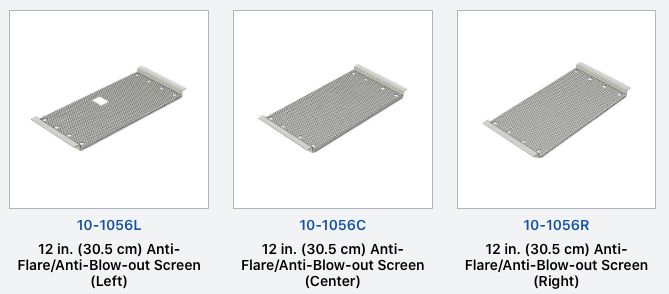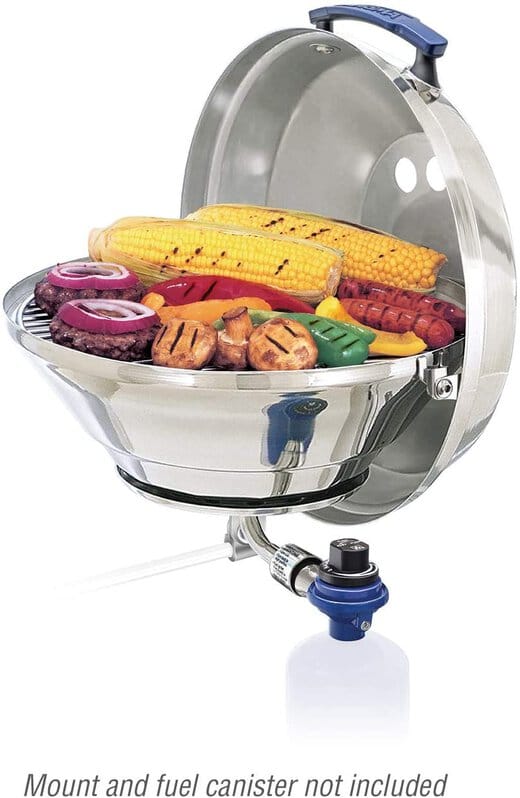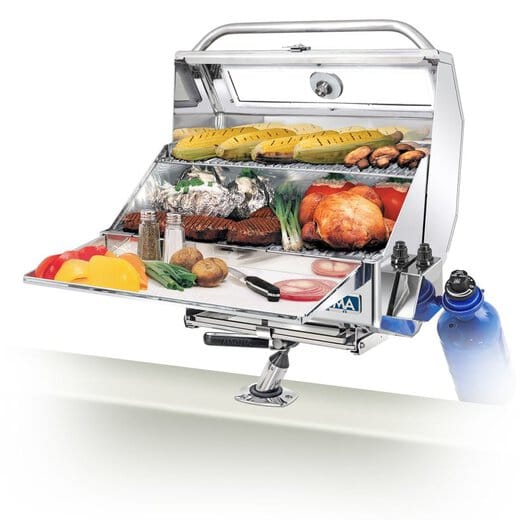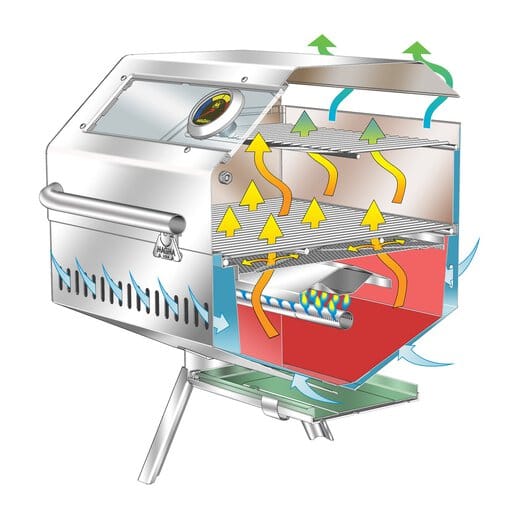Boat Grills and related
Hamburgers, hot dogs, sausages, corn on the cob in the husk
and more - chicken, kabobs, baked and foil potatoes - there are lots of things easily cooked on a frill, and for many, it’s the sole source of cooking ability when at the beach, lake, campground - or a boat.
When it comes to boats and the marine environment, one general rule applies - stainless steel is your friend. Other metals when subjected to the moisture and water eventually give out, sometimes a lot more quickly than one might expect.
Looking for a marine-specific grill, it becomes quikcly apparent there are only a few brands out there, the biggest one being Magma, who also has a Factory Outlet Store, although I’m unsure there are actually any discounts to be found there - but it does at least show when a national backorder is in effect, which sadly does happen. If an item shows as back-ordered on the outlet store, uou probably want to check Amazon and anywhere else and picking it up if you find someone with the item in stock.
Where to mount the grill?
There are a small handful of options to consider
-
Mounted to a new or existing rod holder on the side of the boat
-
This works well for boats so equipped and can be a nice setup if re-using an already-existing rod holder or you’re comfortable drilling into your hull. The pictures below for the Catalina 2 and Stow n Go 160 are using rod holder mounts.
-
Not the best solution if planning on running full camper canvas while cooking.
-
-
Rail-mount options or other hull-mounted option.
-
Specific to your boat’s layout, but if you plan to put the grill in easy reach of an existing rail and don’t plan on doing camper canvas or using it while grilling, could be a drill-free option.
-
Some dual-mount options exist which can certainly be sturdy but require drilling additional holes into the hull. Consider fuel, water and waste tank locations and lines before considering.
-
-
Swim platform mounted on a pedestal
-
These are removable with a pedestal similar to table mounts, but require a base plate which remains in place, with the grill locking down onto the pedestal pole.
-
Some platforms may be easier to mount the base on that others; ideally you want screws going all the way through, or into an accessible area with fender washers, lock-washers and nuts on the other side; not just screwing into the platform!
-
Allows some flexibility of mounting
-
Some put the base plate inside the swim platform ladder hatch, thus completely hiding the base plate when not in use. This location does, however, limit the use of the ladder while grilling, so consider your specific use before drilling holes!
-
Others choose different locations on the swim platform, in some cases to allow grilling from the piece; just make sure not to block the transom door!
-
-
-
Technically, there is one other option out there for those with a topside table mount and pedestal - you may be able to modify to have the grill mount to this pedestal, or even set the grill onto a table. I’m not going to recommend either of these personally, as the risk of dripping grease, hot oil, etc. is just too great of a risk, IMO.
Both the rod holder and swim platform mounts were initially attractive options, although I’d need to drill a new hole into the boat for a rod holder option. Considering the fact we’d be leaving the full camper up a fair amount, as well as grilling dinners in the slip, no matter how cool the rod holder option seemed, a pedestal mount would let me grill standing on the slip at enough distance from the canvas to reduce concern, then being able to head onto the boat to enjoy dinner while letting the grill cool down.
Options for boat grills
There are really only two choices here, each with pros and cons:
-
A non-marine general purpose grill
-
Camping, tailgating or portable grills that you manage to work out mounting, or sitting (hopefully securely!) on a table of some kind. Mounting usually isn’t that big of a deal - if you can drill a few holes in the bottom of a grill, you can probably manage to get a grill mounted to one of the existing marine grill mounts.
-
Pros: Usually cheaper, sometimes much cheaper than marine designated grills.
-
Cons: Extra effort in mounting and may not hold up over time.
-
-
A purpose-build marine grill
-
This usually, and should, imply an all-stainless steel grill
-
Pros: Generally built to last a while in marine environments, designed for relatively easy mounting options, ‘quick path’ to having a boat grill set up that generally works
-
Cons: Cost, and sometimes availability. Don’t wait until a week before July 4th to buy a grill!
-
If you’re considering a non-marine grill, be sure to search for others using that specific grill on a boat, preferably over time. There are lots of stories of ‘love my brand new non-marine grill on my boat!’ but quite a few less saying how they still love them a year or two later…with ‘enough’ stories out there of the grills simply rusting or rotting out to usually be replaced with….a marine grill.
We all make our choices… I really don’t like throwing money at a problem, but even less so - doing it over and over, so decidded from the start to just bite the bullet (and higher cost :( ) and start out with a purpose-built marine grill.
Who makes marine-suitable grills?
Technically this includes both marine-specific and a few that are not but appear to be more suitable than others. Surprisingly, the list is still pretty small. These are the ones I’ve found to date:
-
Magma Products
-
They’re pretty much the name in marine grills. They offer a ton of different models as well as cookware and accessories.
-
The Magma Kettle series is quite popular, along with some more traditional rectangular-shaped grills in different sizes.
-
Not inexpensive, but the standard. Might be worth doing the grill and grill mount from them and accessories from someone else if trying to save a few bucks.
-
-
Kuuma
-
They seem to be making a few ‘clones’ of some of the Magma grills offer accessories like their own grill mounts, and prices a bit lower than Magma.
-
No personal idea as to their relative quality or grill performance, but may be worth a look
-
The Kuuma Stow n Go 160 is one example. Amazon doesn’t carry all of their grills, but Wholesale Marine does in this case, while Amazon has a fair number of Kuuma accessories and some of their grills.
-
-
-
Produces non-marine grills, smokers and accessories
-
Has a Model 205 stainless grill hich looks like it may be workable for marine use, at a pretty attractive price. Unfortunately it has reviews all over the place ranging from great to awful and everywhere in between.
-
Would need to fabricate or adapt a grill mount.
-
-
Solaire
-
Not specifically marine grills, but offers a number of all-stainless grills, such as an Anywhere with warming rack
-
Has a fairly wide range of grills
-
Priced similarly or higher vs Magma
-
And that’s about it, at least as applies in the general range for the size of boat I’m working with - I suspect this will be many of you, as well, as let’s face it, if you own a 50foot+ yacht, you’ve probably paid someone to go do research or just ‘get it done,’ while the rest of us do it ourselves.. ;)
A few other stainless grills can be found, such as the Cuisinart CFF-306 all stainless - YMMV as always, but always see if you can at least find reviews of people using them on boats. Some simpler things, like the ability to stay lit when out on the water, may not be inherently obvious, or where non-stainless fasteners or parts may be used.
Other grill considerations
Consider not only what you’ll cook, but for how many and how many things at once
For example, cooking for 2 makes it easier to find a smaller (and cheaper!) grill that might work, but if you also intend on cooking, meats, veggies and foil packet type meals all at the same time - vs just throwing on a few burgers now and then, has an impact on what size or type grill is needed to make you happy.
If you also are planning on using the grill to boil or steam - this may also influence your choice.
Where will you store it?
Depending on your boat size and it’s relative amount of storage, one of the grills may fit your situation better simply based on storing it when not in use. For us it’s somewhat of a lesser concern, as we’ll store it regularly in our dock box, and in a case at the rear of the boat when we’re heading out, as it will generally just be the two of us onboard. Having said that, there are enough other things we want to keep ‘in their right places’ aboard the boat that it’s always worth considering how and where you’ll be storing things.
More considerations
I really liked the Magma Kettle 3 once I realized you could take the grill grate off and drop a wok or pan right into the grill. Initially, I thought this would be great, and it probably could be, for anything from boiling vegetables to boiling water for coffee. It comes in a standard and ‘XL’ size, with the standard size being claimed to be right for 2 people. Noting of course, people grill differently, and different foods. Note the XL size is called ‘Party’ size, and there are both the oirignal Kettle (A10-205 and A10-215(Party size)) and the newer Kettle 3(A10-207 and A10-217(Party size)) out there for purchase. The standard size has a 13” diameter grill, while the Party Size has a 15” diameter grill - not a huge difference in overall size, but it might make the difference when cooking multiple things concurrently. Some grill series offer a variety of different cooking surface/grate sizes, so it’s worth considering just how much food you realistically plan on cooking at the same time.
I went back and forth for some time between the Kettle 3 Party Size and a rectangular grill. The primary benefit of the Kettle is allowing the use to boil water for coffee, or more easily and securely using a wok or pan with the grill grate or grate and radiant plate removed. Plus it is kinda cute, right?
The biggest downside is when we grill, I usually wind up grilling multiple things, whether it’s baked potatoes or corn alongside of some chicken or steak, and routinely use both multi-burners on the home grill at different heat settings as well as the warming rack to start stacking nearly-done corn and other things on.
Unfortunately but somewhat understandably, with most marine grills being smaller cousins to your typical backyard grills, all marine grills in this general size category are single burner grills. Further, only one of the Solaires and Magma Catalina 2 grills offer a warming rack at all. So for me, it literally came down to the convenience of being able to use the Kettle 3 as a stove, or having a warming rack. Eventually, the warming rack won out, with the Magma Catalina 2’s rounded edges winning out over the relatively sharp bits on the Solaire, and the decision was made for me to go with the infrared model, as only the infrared version of the Catalina 2 had the glass cover on the front. The 12” D x 18” L grill size also seemed ‘about right’ for us as we try to work out how to do veggies alongside typical meats and such, or as typical, cook a bunch of things to have leftovers later..
What are infrared grills anyways?
Considering my existing stainless backyard grill is still working over a decade later, the term infrared grill wasn’t one I was familiar with. Lots of articles and comments out there ranging from the best thing ever to this is awful! and a few in-between.
A ‘normal’ gas grill uses it’s burner to effectively heat the air, which then cooks your food. The grill grates also of course heat up and contribute as well.
An infrared grill by comparison, has a heat sink of sorts, usually steel, ceramic or glass, above the burner(s), which instead absorbs the heated air from the flame, and radiates heat upwards to cook your food.
Sounds pretty simple, and it is, to an extent. As air is a not-so-great conductor of heat, infrared grills are more efficient in general, and can get hotter, which can lead to foods cooking more quickly on infrared grills. A typical gas grill may get to 450-550*F, while some infrared grills can reach up to 1000*F or more. A fun fact is the toaster in your home is technically an infrared device.
There are claims that infrared grills can sear meats quicker, better, etc. Depending on whom you ask, you might learn that searing of meats happens below 500*F, and that burning and charring of foods can happen pretty quickly over 500*F and can increase carcinogens.
They do cook foods faster, and it seems like steaks are one of the primary contenders for the ‘infrared is better’ camp, although it may be challenging to cook vegetables and others. Compounding this, it seems like many grill manufacturers’ regulators don’t have all that much adjustment to them, at least on the marine models as of yet.
Some grills may be offered in both infrared and ‘classic’ models. For example, the Magma Newport models come in both infrared and ‘classic’ modes - note the primary difference between the cooking elements is a set of (removable) plates…and around $80 or so.
On the infrared model, there are 3 ‘plates’ sitting right below the grill grate surface. The one on the left is notched so it fits over a hoop on the radiant plate - which exists on both the infrared and classic models. These plates are shown below with Magma’s part numbers, while the grill case is an identical part number so the real difference is the plates + the infrared model has the glass window in the top cover as well.

I’m still not hooked on the idea of infrared for all purposes, but as the grills in infrared and ‘classic’ modes are the same, except for the infrared ‘screens’ - I can always convert back to ‘normal’ mode, and perhaps mix and match leaving a portion of the grill with the screens in place, and removing one or two as needs dictate. We’ll see how that goes.
This stuff is kind of expensive - are there any other options?
Well - if you’re set on a marine grill, the Kettle isn’t terribly priced if it works for you, and it may work very well.
In our case, I really wanted the warming rack, while only the Catalina series for the Magma seems to offer it.
The Newport is a bit more reasonably priced if the cheaper Kettle won’t work for you, or you can try one of the non-Magma offerings listed previously. A few have gone so far as to make mounts for a Chefsmate or camping type of grill, while for me in this case - I was really looking for ready to go, as wanted, without adding too many more projects to the list.
Don’t forget the grill is sadly not the only purchase - you’ll need a grill mount in most cases, possibly a cover, etc.
If you do try to modify or use a non-marine grill, just do the best you can to ensure it’s actually all stainless components and not stainless ’touch,’ or mixed between stainless and other metals, as non-stainless can have a hard time holding up over time.
So what about pans, coffee, and you know - boiling stuff?
There’s definately a bit more to come. I’ll cover mounting the grill grill accessories and even cookware - as well as how to do one of the most important things - make coffee!! - in other articles.



